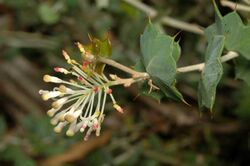Biology:Grevillea amplexans
| Grevillea amplexans | |
|---|---|

| |
| Scientific classification | |
| Kingdom: | Plantae |
| Clade: | Tracheophytes |
| Clade: | Angiosperms |
| Clade: | Eudicots |
| Order: | Proteales |
| Family: | Proteaceae |
| Genus: | Grevillea |
| Species: | G. amplexans
|
| Binomial name | |
| Grevillea amplexans F.Muell. ex Benth.[2]
| |
| Subspecies | |
| |
Grevillea amplexans is a species of flowering plant in the family Proteaceae and is endemic to the Mid West region of Western Australia. It is a spreading shrub with arching branches, stem-clasping, sharply-pointed, lobed or toothed leaves and white to cream-coloured flowers.
Description
Grevillea amplexans is a spreading shrub that typically grows to a height of 1–3 m (3 ft 3 in–9 ft 10 in) and has arching branches. Its leaves are 7–26 mm (0.28–1.02 in) long, 10–35 mm (0.39–1.38 in) wide and star-shaped or egg-shaped with three to seven lobes or five to eleven teeth on the edges, and a stem-clasping base. The flowers are arranged in more or less spherical to domed groups on the ends of branches. The flowers are white to cream-coloured and glabrous, the pistil 2.5–5.8 mm (0.098–0.228 in) long with a white style. Flowering occurs from July to December and the fruit is an oblong follicle 9–12 mm (0.35–0.47 in) long.[3][4]
Taxonomy
Grevillea amplexans was first formally described in 1870 by George Bentham from an unpublished description by Ferdinand von Mueller in Flora Australiensis.[5] The specific epithet (amplexans) means "encircling" or "embracing", referring to the base of the leaves.[6]
In 2000, Makinson and Wilson described three subspecies in the Flora of Australia, and the names are accepted by the Australian Plant Census:
- Grevillea amplexans subsp. adpressa (Olde & Marriott) Makinson[7] tends to have smaller leaves than subsp. amplexans and often has down-curved leaf edges;[8][9]
- Grevillea amplexans F.Muell. ex Benth. subsp. amplexans;[10][11][12]
- Grevillea amplexans subsp. semivestita Makinson[13] is distinguished from the autonym by its silky-hairy branchlets and glabrous, sometimes glaucous lower leaf surfaces.[14][15]
(Grevillea amplexans subsp. adpressa was first formally described in 1993 by Olde and Marriott who gave it the name Grevillea adpressa in the journal Nuytsia.)[16][17]
Distribution and habitat
This grevillea grows in sand on sandplains between Geraldton, Coomberdale and Moora in the Avon Wheatbelt, Geraldton Sandplains and Swan Coastal Plain biogeographic regions of Western Australia.[4] Subspecies adpressa grows in low heath between Mingenew and Watheroo,[8][9] and subsp. amplexans grows in heathland or mallee-shrubland[11][12] and subsp. semivestita occurs in shrubland and heath from Watheroo National Park to near Carnamah.[14][15]
Conservation status
Grevillea amplexans is listed as an endangered species by the International Union for Conservation of Nature, due to having an area of occupancy less than 200 km2, a severely fragmented range and a continuing decline of habitat due to ongoing clearance of roadside verges. Other potential threats to the species include altered fire regimes and competition with invasive weed species.[1]
Subspecies amplexans is classified as "not threatened" by the Government of Western Australia Department of Biodiversity, Conservation and Attractions,[12] but subsp. adpressa is listed as "Priority One" meaning that it is known from only one or a few locations which are potentially at risk,[18] and subsp. semivestita as "Priority Two"[15] meaning that it is poorly known and from only one or a few locations.[18]
References
- ↑ 1.0 1.1 Keighery, G.; Makinson, R.; Monks, L. (2020). "Grevillea amplexans". IUCN Red List of Threatened Species 2020: e.T112645835A113307636. doi:10.2305/IUCN.UK.2020-2.RLTS.T112645835A113307636.en. https://www.iucnredlist.org/species/112645835/113307636. Retrieved 20 December 2023.
- ↑ "Grevillea amplexans". Australian Plant Census. https://biodiversity.org.au/nsl/services/apc-format/display/81232.
- ↑ "Grevillea amplexans". Australian Biological Resources Study, Department of Agriculture, Water and the Environment: Canberra. https://profiles.ala.org.au/opus/foa/profile/Grevillea%20amplexans.
- ↑ 4.0 4.1 "Grevillea amplexans". FloraBase. Western Australian Government Department of Parks and Wildlife. https://florabase.dpaw.wa.gov.au/browse/profile/1951.
- ↑ "Grevillea amplexans". APNI. https://id.biodiversity.org.au/instance/apni/497626.
- ↑ Sharr, Francis Aubi; George, Alex (2019). Western Australian Plant Names and Their Meanings (3rd ed.). Kardinya, WA: Four Gables Press. p. 131. ISBN 9780958034180.
- ↑ "Grevillea amplexans subsp. adpressa". Australian Plant Census. https://biodiversity.org.au/nsl/services/apc-format/display/162205.
- ↑ 8.0 8.1 "Grevillea amplexans subsp. adpressa". Australian Biological Resources Study, Department of Agriculture, Water and the Environment: Canberra. https://profiles.ala.org.au/opus/foa/profile/Grevillea%20amplexans%20subsp.%20adpressa.
- ↑ 9.0 9.1 "Grevillea amplexans subsp. adpressa". FloraBase. Western Australian Government Department of Parks and Wildlife. https://florabase.dpaw.wa.gov.au/browse/profile/19434.
- ↑ "Grevillea amplexans subsp. amplexans". Australian Plant Census. https://biodiversity.org.au/nsl/services/apc-format/display/156454.
- ↑ 11.0 11.1 "Grevillea amplexans subsp. amplexans". Australian Biological Resources Study, Department of Agriculture, Water and the Environment: Canberra. https://profiles.ala.org.au/opus/foa/profile/Grevillea%20amplexans%20subsp.%20amplexans.
- ↑ 12.0 12.1 12.2 "Grevillea amplexans subsp. amplexans". FloraBase. Western Australian Government Department of Parks and Wildlife. https://florabase.dpaw.wa.gov.au/browse/profile/19357.
- ↑ "Grevillea amplexans subsp. semivestita". Australian Plant Census. https://biodiversity.org.au/nsl/services/apc-format/display/162206.
- ↑ 14.0 14.1 "Grevillea amplexans subsp. semivestita". Australian Biological Resources Study, Department of Agriculture, Water and the Environment: Canberra. https://profiles.ala.org.au/opus/foa/profile/Grevillea%20amplexans%20subsp.%20semivestita.
- ↑ 15.0 15.1 15.2 "Grevillea amplexans subsp. semivestita". FloraBase. Western Australian Government Department of Parks and Wildlife. https://florabase.dpaw.wa.gov.au/browse/profile/19426.
- ↑ "Grevillea adpressa". APNI. https://id.biodiversity.org.au/instance/apni/165115.
- ↑ Olde, Peter M.; Marriott, Neil R. (1993). "New species and taxonomic changes in Grevillea (Proteaceae: Grevilleoideae) from south-west Western Australia". Nuytsia 9 (2): 250–252. https://www.biodiversitylibrary.org/item/224642#page/120/mode/1up. Retrieved 20 November 2021.
- ↑ 18.0 18.1 "Conservation codes for Western Australian Flora and Fauna". Government of Western Australia Department of Parks and Wildlife. https://www.dpaw.wa.gov.au/images/documents/plants-animals/threatened-species/Listings/Conservation%20code%20definitions.pdf. Retrieved 16 December 2015.
Wikidata ☰ {{{from}}} entry
 |


